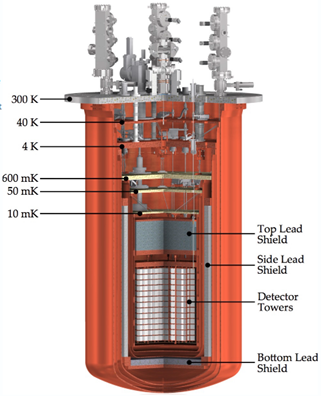
To observe double beta decay, extremely low temperatures are necessary to measure the small temperature changes.
In the search of rare events, such as double beta decay without neutrinos emission, one exploits the fact that in general a small release of energy within a crystal can be interpreted as a change of temperature. This variation can be only measured if the experimental apparatus is kept at extremely low temperatures. At the LNGS the coldest cubic meter of the universe has been created, realizing a cooling system made of concentric shells, that are gradually getting colder and colder.
Laboratori Nazionali del Gran Sasso (LNGS) at INFN hosts several experiments in the search for an extremely rare and, so far never observed, nuclear decay: a transformation of an atomic nucleus. One of these, the CUORE project, aims to measure the rise in temperature produced by the minuscule amount of energy released inside a crystal caused by this kind of decay. This temperature variation is extremely small, in the order of tens of millikelvins (1 millikelvin is a thousandth part of a degree Celsius). Such a rise cannot be measured at room temperature as the thermal excitation of the atoms masks it. In fact, temperature is the measurement of the average thermal excitation state of the atoms composing a body: the higher the temperature in a volume, the higher the fluctuation of a single atom in that volume. As the temperature approaches absolute zero (-273,16 °C) the particle thermal excitation becomes very slight and hence the temperature fluctuation. For this reason the CUORE detector needs to be cooled down to extremely low temperatures, called cryogenic temperatures. Infact CUORE stands for “Cryogenic Underground Observatory for Rare Events”.
A machine used to cool to extremely low temperatures is called a cryostat. The CUORE cryostat is the largest and most powerful of its kind ever built. It consists of an array of cylindrical concentric vessels. From the outside to the inside of the cryostat, each vessel is cooled to a lower temperature than the previous one (Fig.1). The cooling process has two different stages. The first stage cools the outer layers to a cold a few degrees above absolute zero. This apparatus, the pulse tube, is a mechanical system of tubes and valves where a gas lowers the temperature by undergoing multiple cycles of compression and expansion. At the second stage the innermost volume of the cryostat cools down to 10 mK. The socalled dilution refrigerator with helium double phase profits from the characteristics of the mixtures of two helium isotopes: helium-3 and helium-4. Below a given temperature the mixture spontaneously separates into two phases: one rich in helium-3, named the concentrated phase, and one composed almost entirely of helium-4, called the diluted phase. As helium-3 is the lightest of the two isotopes, the condensed phase floats up on top of the diluted one. Helium-3 is then pumped from the concentrated phase through the separation surface between the two phases, by means of a pumping apparatus. This passage is crucial as it is an endothermal process, that means that it absorbs heat from the surrounding environment, generating a cooling down. Using this system CUORE has established an impressive record: the inner volume at the heart of the CUORE cryostat is actually the coldest cubic meter in the whole of the universe.

Fig.1 Section view of the CUORE experiment. The cylindrical concentric vessel configuration allows progressive cool down from the outside (top) to the inside to progressively lower temperatures (on the left in the figure, from 300K to 10mK). On the right, placed in the center of the cryostat, we can see the lead shields used to protect the CUORE detector from radiations that can spoil the precision of the measurement.

Discover the experiments and help the alien to get back home!
Play now